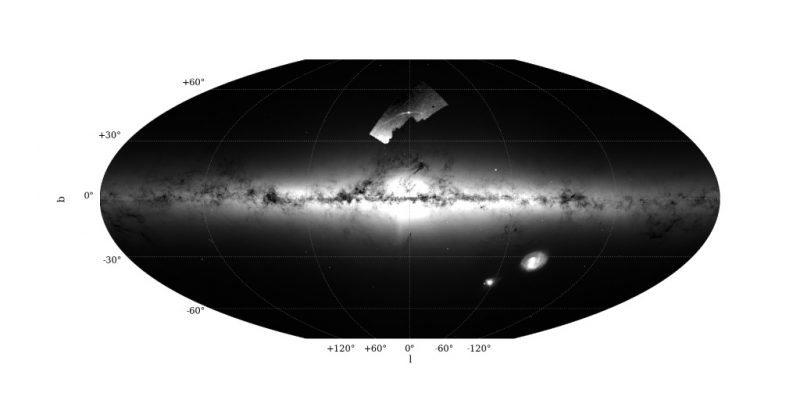100 black holes
The globular star cluster Palomar 5 has always been strange. The cluster is one of the “fluffiest” known, It’s less massive than other globulars and has a greater distance between its stars. It also has two long streamers of stars flowing away from the cluster. And now astronomers have found a new quirk of Palomar 5: it’s hiding more than 100 black holes at its center. A team of astronomers announced July 1, 2021, that this unusual globular cluster has about three times as many black holes as expected. Some 20% of the cluster’s mass comes from black holes. These astronomers said that, one day, the stars will be gone, and nothing will remain but the black holes.
The scientists published their study on July 5, 2021, in the peer-reviewed journal Nature Astronomy.
Palomar 5 is a globular cluster, a huge ball of stars that orbits in the halo of the Milky Way. Discovered by Walter Baade in 1950, Palomar 5 lies 65,000 light-years away from us in the direction of the constellation Serpens. This globular cluster is ancient – more than 10 billion years old – because it formed at the same time as the galaxy. The globular cluster is in the process of dissipating, and long streamers of stars are flowing away from it out into space.

A black-hole-heavy globular star cluster
Palomar 5 has an unusual number of black holes for a globular cluster. Mark Gieles of the University of Barcelona and lead author of the paper said:
The number of black holes is roughly three times larger than expected from the number of stars in the cluster, and it means that more than 20% of the total cluster mass is made up of black holes. They each have a mass of about 20 times the mass of the sun, and they formed in supernova explosions at the end of the lives of massive stars, when the cluster was still very young.

A Rosetta stone of tidal streams
The black-hole heavy cluster is losing stars as they flow away from the cluster out into space, leaving long tails visible in deep-sky surveys. Tidal streams, as they are called, are made up of stars that were ejected from disrupting star clusters or dwarf galaxies. Palomar 5 is the only globular star cluster displaying tidal streams. But in the last few years, astronomers have discovered almost 30 thin tidal streams unconnected to clusters in the Milky Way’s halo. As Gieles said:
We do not know how these streams form, but one idea is that they are disrupted star clusters. However, none of the recently discovered streams have a star cluster associated with them, hence we cannot be sure. So, to understand how these streams formed, we need to study one with a stellar system associated with it. Palomar 5 is the only case, making it a Rosetta stone for understanding stream formation and that is why we studied it in detail.
The higher black hole concentration may play a key in the formation of tidal streams. He continued:
We have shown that the presence of a large black hole population may have been common in all the clusters that formed the streams.
From globular to black hole cluster
Using computer modeling, the scientists ran different simulations until they found one that matched the properties of Palomar 5. They found that Palomar 5 likely formed with a lower concentration of black holes. Then stars escaped more easily than black holes, so that the fraction of black holes to stars in the cluster increased. The black hole interactions with the stars created gravitational slingshots, which helped create its “fluffy” appearance and led to more stars escaping and fueling the exiting tidal stream. The scientists said that a billion years from now, just before the cluster completely dissolves, it will consist entirely of black holes.
The scientists’ study gives us a more complete picture for understanding globular cluster formation, the initial masses of stars and the evolution of massive stars, and has important implications for gravitational waves.
Bottom line: Scientists have discovered that the globular cluster known as Palomar 5 has a large proportion of black holes and will one day lose all its stars and be made entirely of black holes.
Source: A supra-massive population of stellar-mass black holes in the globular cluster Palomar 5
Via the University of Barcelona
The post Astronomers find 100 black holes in Palomar 5 first appeared on EarthSky.
from EarthSky https://ift.tt/3dYAubf
100 black holes
The globular star cluster Palomar 5 has always been strange. The cluster is one of the “fluffiest” known, It’s less massive than other globulars and has a greater distance between its stars. It also has two long streamers of stars flowing away from the cluster. And now astronomers have found a new quirk of Palomar 5: it’s hiding more than 100 black holes at its center. A team of astronomers announced July 1, 2021, that this unusual globular cluster has about three times as many black holes as expected. Some 20% of the cluster’s mass comes from black holes. These astronomers said that, one day, the stars will be gone, and nothing will remain but the black holes.
The scientists published their study on July 5, 2021, in the peer-reviewed journal Nature Astronomy.
Palomar 5 is a globular cluster, a huge ball of stars that orbits in the halo of the Milky Way. Discovered by Walter Baade in 1950, Palomar 5 lies 65,000 light-years away from us in the direction of the constellation Serpens. This globular cluster is ancient – more than 10 billion years old – because it formed at the same time as the galaxy. The globular cluster is in the process of dissipating, and long streamers of stars are flowing away from it out into space.

A black-hole-heavy globular star cluster
Palomar 5 has an unusual number of black holes for a globular cluster. Mark Gieles of the University of Barcelona and lead author of the paper said:
The number of black holes is roughly three times larger than expected from the number of stars in the cluster, and it means that more than 20% of the total cluster mass is made up of black holes. They each have a mass of about 20 times the mass of the sun, and they formed in supernova explosions at the end of the lives of massive stars, when the cluster was still very young.

A Rosetta stone of tidal streams
The black-hole heavy cluster is losing stars as they flow away from the cluster out into space, leaving long tails visible in deep-sky surveys. Tidal streams, as they are called, are made up of stars that were ejected from disrupting star clusters or dwarf galaxies. Palomar 5 is the only globular star cluster displaying tidal streams. But in the last few years, astronomers have discovered almost 30 thin tidal streams unconnected to clusters in the Milky Way’s halo. As Gieles said:
We do not know how these streams form, but one idea is that they are disrupted star clusters. However, none of the recently discovered streams have a star cluster associated with them, hence we cannot be sure. So, to understand how these streams formed, we need to study one with a stellar system associated with it. Palomar 5 is the only case, making it a Rosetta stone for understanding stream formation and that is why we studied it in detail.
The higher black hole concentration may play a key in the formation of tidal streams. He continued:
We have shown that the presence of a large black hole population may have been common in all the clusters that formed the streams.
From globular to black hole cluster
Using computer modeling, the scientists ran different simulations until they found one that matched the properties of Palomar 5. They found that Palomar 5 likely formed with a lower concentration of black holes. Then stars escaped more easily than black holes, so that the fraction of black holes to stars in the cluster increased. The black hole interactions with the stars created gravitational slingshots, which helped create its “fluffy” appearance and led to more stars escaping and fueling the exiting tidal stream. The scientists said that a billion years from now, just before the cluster completely dissolves, it will consist entirely of black holes.
The scientists’ study gives us a more complete picture for understanding globular cluster formation, the initial masses of stars and the evolution of massive stars, and has important implications for gravitational waves.
Bottom line: Scientists have discovered that the globular cluster known as Palomar 5 has a large proportion of black holes and will one day lose all its stars and be made entirely of black holes.
Source: A supra-massive population of stellar-mass black holes in the globular cluster Palomar 5
Via the University of Barcelona
The post Astronomers find 100 black holes in Palomar 5 first appeared on EarthSky.
from EarthSky https://ift.tt/3dYAubf

Aucun commentaire:
Enregistrer un commentaire